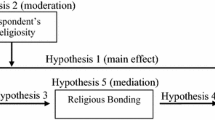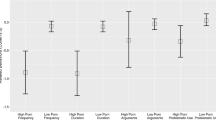Abstract
Frequent pornography use is often negatively associated with marital quality. Recent research has argued that this negative association is particularly strong for those who are embedded in religious communities, likely due to the greater stigma and shame associated with viewing pornography. In order to test and extend this theory, the current study examined how religious service attendance moderates the link between parents’ pornography consumption and four measures of parent–child relationship quality. Analyses of 2006 Portraits of American Life Study data (N = 2610) revealed that greater pornography viewing predicted negative outcomes on two out of four measures of parent–child relationship quality, while religious service attendance was associated with more positive parent–child relationship outcomes. Interaction effects, however, affirmed that the negative association between porn viewing frequency and three parent–child relationship outcomes was stronger for participants who attended religious services more often. Analyzing fathers (N = 771) and mothers (N = 904) separately revealed that the observed relationships held more consistently for fathers than mothers. Evidence for directionality was presented by incorporating re-interview data from 2012. While pornography use may be negatively associated with some aspects of parent–child relationship quality, this association was particularly strong for those embedded within religious communities, possibly owing to greater attendant guilt and shame.

Similar content being viewed by others
Notes
The two variables about having children either in or out of the home are not mutually exclusive. Though several of the outcomes like eating at the same table with one’s children or yelling at one’s children would primarily take place when children are in the home, and less so when children are out of the home, we include them both in order to account for parents who are either in blended families (with younger and older children) or have simply been parents longer. Supplementary analyses alternated including either variable across all models to test for whether including both variables made any difference in the substantive findings. No significant differences were detected.
Full results are available upon request from the corresponding author.
Descriptive statistics from the 2012 PALS data are available upon request from the corresponding author.
The only significant difference in the measures from Table 3 and the analyses with 2012 PALS data are that the 2006 PALS data asked participants whether they had children in the home and whether they had children out of the home. Wave 2 of PALS only asked participants how many children they had, so this was the only control about children included.
References
Attwood, F. (2011). The paradigm shift: Pornography research, sexualization and extreme images. Sociology Compass, 5, 13–22.
Baltazar, A., Helm, H. W., McBride, D., Hopkins, G., & Stevens, J. V. (2010). Internet pornography use in the context of external and internal religiosity. Journal of Psychology and Theology, 38, 32–40.
Bergner, R. M., & Bridges, A. J. (2002). The significance of heavy pornography involvement for romantic partners: Research and clinical implications. Journal of Sex and Marital Therapy, 28, 193–206.
Bridges, A. J., Bergner, R. M., & Hesson-McInnis, M. (2003). Romantic partner’s use of pornography: Its significance for women. Journal of Sex and Marital Therapy, 29, 1–14.
Bridges, A. J., & Morokoff, P. J. (2011). Sexual media use and relational satisfaction in heterosexual couples. Personal Relationships, 18, 562–585.
Carroll, J. S., Padilla-Walker, L. M., Nelson, L. J., Olson, C. D., McNamara Barry, C., & Madsen, S. D. (2008). Generation XXX: Pornography acceptance and use among emerging adults. Journal of Adolescent Research, 23, 6–30.
Corley, M. D., & Schneider, J. P. (2003). Sex addiction disclosure to children: The parents’ perspective. Sexual Addiction & Compulsivity, 10, 291–324.
Doran, K., & Price, J. (2014). Pornography and marriage. Journal of Family and Economic Issues, 35, 489–498.
Doring, N. M. (2009). The internet’s impact on sexuality: A critical review of 15 years of research. Computers in Human Behavior, 25, 1089–1101.
Driscoll, M. (2009). Porn again Christian: A frank discussion on pornography and masturbation. The Resurgence: E-book.
Edelman, B. (2009). Red light states: Who buys on-line adult entertainment. Journal of Economic Perspectives, 23, 209–220.
Emerson, M. O., & Sikkink, D. (2006–2012). Portraits of American Life Study, 2006–2012.
Emerson, M. O., Sikkink, D., & James, A. (2010). The Panel Study on American religion and ethnicity: Background, methods, and selected results. Journal for the Scientific Study of Religion, 49, 162–171.
Folbre, N., & Bittman, M. (2004). Family time: The social organization of care. New York: Routledge.
Grov, C., Gillespie, B. J., Royce, T., & Lever, J. (2011). Perceived consequences of casual online sexual activities on heterosexual relationships: A U.S. online survey. Archives of Sexual Behavior, 40, 429–439.
Grubbs, J. B., Exline, J. J., Pargament, K. I., Hook, J. N., & Carlisle, R. D. (2015). Transgression as addiction: Religiosity and moral disapproval as predictors of perceived addiction to pornography. Archives of Sexual Behavior, 44, 125–136.
Kraemer, H. C., & Blasey, C. M. (2004). Centering in regression analyses: A strategy to prevent errors in statistical inference. International Journal of Methods in Psychiatric Research, 13, 141–151.
Lambert, N. M., Negash, S., Stillman, T. F., Olmstead, S. P., & Fincham, F. D. (2012). A love that doesn’t last: Pornography consumption and weakened commitment to one’s romantic partner. Journal of Social and Clinical Psychology, 31, 410–438.
Maddox, A. M., Rhoades, G. K., & Markman, H. J. (2011). Viewing sexually-explicit materials alone or together: Associations with relationship quality. Archives of Sexual Behavior, 40, 441–448.
Mahoney, A. (2010). Religion in families, 1999–2009: A relational spirituality framework. Journal of Marriage and Family, 72, 805–827.
Maltz, W., & Maltz, L. (2010). The porn trap: The essential guide to overcoming problems caused by pornography. New York: Harper.
Manning, J. C. (2006). The impact of internet pornography on marriage and the family: A review of the research. Sexual Addiction & Compulsivity, 13, 131–165.
Miller, C. H., & Hedges, D. W. (2008). Scrupulosity disorder: An overview and introductory analysis. Journal of Anxiety Disorders, 22, 1042–1058.
Muusses, L. D., Kerkhof, P., & Finkenauer, C. (2015). Internet pornography and relationship quality: A longitudinal study of within and between partner effects of adjustment, sexual satisfaction and sexually explicit material among newlyweds. Computers in Human Behavior, 45, 77–84.
Nelson, L. J., Padilla-Walker, L. M., & Carroll, J. S. (2010). “I believe it is wrong but I still do it”: A comparison of religious young men who do versus do not use pornography. Psychology of Religion and Spirituality, 2, 136–147.
Olmstead, S. B., Negash, S., Pasley, K., & Fincham, F. D. (2013). Emerging adults expectations for pornography use in the context of future committed romantic relationships: A qualitative study. Archives of Sexual Behavior, 42, 625–635.
Patterson, R., & Price, J. (2012). Pornography, religion, and the happiness gap: Does pornography impact the actively religious differently? Journal for the Scientific Study of Religion, 51, 79–89.
Perry, S. L. (2015). Pornography consumption as a threat to religious socialization. Sociology of Religion, 76, 436–458.
Perry, S. L. (2016a). Does viewing pornography diminish religiosity over time? Evidence from two-wave panel data. Journal of Sex Research. doi:10.1080/00224499.2016.1146203
Perry, S. L. (2016b). Spousal religiosity, religious bonding, and pornography consumption. Archives of Sexual Behavior. doi:10.1007/s10508-016-0896-y
Perry, S. L. (2016c). From bad to worse? Pornography consumption, spousal religiosity, gender, and marital quality. Sociological Forum, 31, 441–464.
Perry, S. L. (2016d). Does viewing pornography reduce marital quality over time? Evidence from longitudinal data. Archives of Sexual Behavior. doi:10.1007/s10508-016-0770-y
Perry, S. L., & Hayward, G. M. (2017). Seeing is (not) believing: How viewing pornography shapes the religious lives of young Americans. Social Forces. doi:10.1093/sf/sow106
Poulsen, F. O., Busby, D. M., & Galovan, A. M. (2013). Pornography use: Who uses it and how it is associated with couple outcomes. Journal of Sex Research, 50, 72–83.
Schneider, J. P. (2000). Effects of cybersex addiction on the family: Results of a survey. Sexual Addiction & Compulsivity, 7, 31–58.
Schneider, J. P. (2003). The impact of compulsive cybersex behaviors on the family. Sexual and Relationship Therapy, 18, 329–354.
Short, M. B., Black, L., Smith, A. H., Wetterneck, C. T., & Wells, D. E. (2012). A review of internet pornography use research: Methodology and content from the past 10 years. Cyberpsychology, Behavior, and Social Networking, 15, 13–23.
Short, M. B., Kasper, T. E., & Wetterneck, C. T. (2015). The relationship between religiosity and internet pornography use. Journal of Religion and Health, 54, 571–583.
Stack, S., Wasserman, I., & Kern, R. (2004). Adult social bonds and use of internet pornography. Social Science Quarterly, 85, 75–88.
Steensland, B., Park, J. Z., Regnerus, M. D., Robinson, L., Wilcox, W. B., & Woodberry, R. (2000). The measure of American religion: Toward improving the state of the art. Social Forces, 79, 291–318.
Willoughby, B. J., & Busby, D. M. (2016). In the eye of the beholder: Exploring variations in the perceptions of pornography. Journal of Sex Research, 53, 678–688.
Willoughby, B. J., Carroll, J. S., Busby, D. M., & Brown, C. C. (2016). Differences in pornography use among couples: Associations with satisfaction, stability, and relationship processes. Archives of Sexual Behavior, 45, 145–158.
Wright, P. J. (2013). U.S. males and pornography, 1973–2010: Consumption, predictors, and correlates. Journal of Sex Research, 50, 60–71.
Wright, P. J., Bae, S., & Funk, M. (2013). United States women and pornography through four decades: Exposure, attitudes, behaviors, and individual differences. Archives of Sexual Behavior, 42, 1131–1144.
Yucel, D., & Gassanov, M. A. (2010). Exploring actor and partner correlates of sexual satisfaction among married couples. Social Science Research, 39, 725–738.
Zillmann, D., & Bryant, J. (1988). Pornography’s impact on sexual satisfaction. Journal of Applied Social Psychology, 18, 438–453.
Zitzman, S. T., & Butler, M. H. (2009). Wives’ experience of husbands’ pornography use and concomitant deception as an attachment threat in the adult pair–bond relationship. Sexual Addiction & Compulsivity, 16, 210–240.
Funding
This study did not receive any direct funding.
Author information
Authors and Affiliations
Corresponding author
Ethics declarations
Conflict of interest
The author declares that he/she has no conflict of interest.
Ethical Approval
This article does not contain any studies with human participants by any of the authors. Secondary data are used.
Rights and permissions
About this article
Cite this article
Perry, S.L., Snawder, K.J. Pornography, Religion, and Parent–Child Relationship Quality. Arch Sex Behav 46, 1747–1761 (2017). https://doi.org/10.1007/s10508-016-0927-8
Received:
Revised:
Accepted:
Published:
Issue Date:
DOI: https://doi.org/10.1007/s10508-016-0927-8




